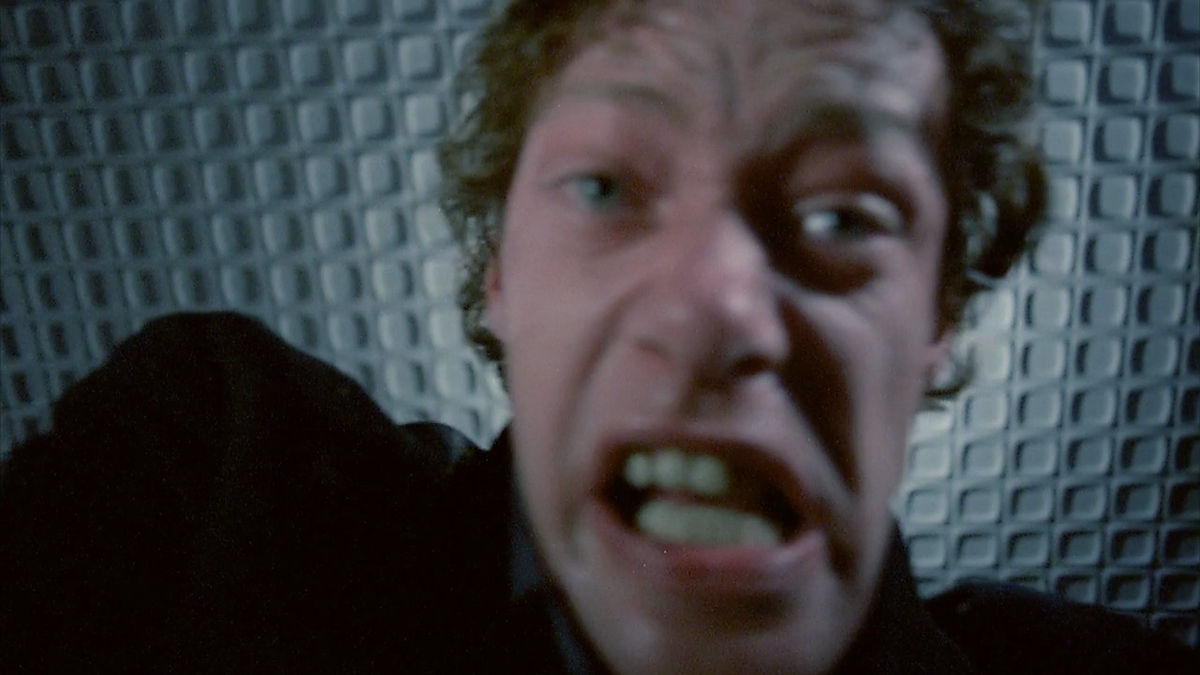Nothing but Flowers

On Gerald Kargl's Angst
For all its brutality, Angst isn’t above having fun. Stop me if you’ve heard this one before: a man — let’s call him The Psychopath — approaches a home, a woman answers the door, and The Psychopath shoots the woman. He flees and is apprehended; he is jailed and he is released. Once out, the Psychopath wastes no time killing again: he tries and fails to strangle a cabbie before he happens upon a remote manor house, where he assaults, tortures, and ultimately kills an elderly woman, her adult daughter, and her disabled son. As you watch The Psychopath defile his victims, performing indignity after indignity for about 75 minutes, you are also presented with his personal history, rife with abuse and neglect, as if something might surface to justify or at least contextualize his unspeakable behavior. Nothing ever does. You follow The Psychopath down a rabbit hole of degradation so far past your limit that the idea of a limit itself becomes a joke. But after all the blood is spilled and the bodies mangled, the most visceral, repulsive thing about this man is the way he eats sausages.
Angst, Austrian director Gerard Kargl’s first and only feature film, is a horror movie, but one that shares the anatomy of a good joke. Think The Aristocrats: a perverse premise is heightened again and again until it spills into slapstick, taking the next beat so far past common sensibility that the one that came before instantly seems tame. The 1983 movie is loosely based on the crimes of Werner Kniesek, one of Austria’s most notorious killers. Over the course of about a day, we follow a nameless man (billed alternatively as “K.” or “The Psychopath” and played with revolting precision by Erwin Leder) as he acts out his darkest compulsions upon whomever is unfortunate enough to find themselves in his way. Far from an exacting killer, The Psychopath operates less like Jeffrey Dahmer and more like Daffy Duck. Guided only by his most immediate impulses, he hatches on a dime schemes that are as likely to send him down a flight of stairs as they are to strike terror in the hearts of his victims.
The absence of any discernible methodology — despite The Psychopath’s successful and horrific kills — sets the stage for Angst’s most effective punchline. After a quick shooting that will soon seem quaint in comparison with what we are yet to see, the film opens with a deep dive into The Psychopath’s personal and criminal history, spoken clinically over a slide show of police-sanctioned evidence and family photos. This introduction is later reiterated by The Psychopath himself, telling his story in his own words in voiceover during the grisly murders of an unsuspecting family that constitute the majority of the film’s runtime. Like any good joke, though, Angst subverts the expectations of cause and effect: there is no key to understanding The Psychopath’s evil, no inciting incident or childhood trauma to satisfy the Why’s and How-Could-He’s that inevitably bubble up. The Psychopath’s history functions more like a red herring than a reliable map of his pathology. There is nothing that can explain the horror he unleashes on his victims, nothing that can forgive or contextualize what they have to endure. It makes the movie all the more terrifying, and yes, perhaps unfortunately, that much funnier.
Ask The Psychopath, and he’ll likely tell you the same thing. “What’s in the newspaper is incorrect,” he says of his motives for the murder that begins Angst. “I only had this feeling, something had to happen.” The Psychopath is far from someone you’re inclined to trust, but he’s shooting straight here. He’s an opportunistic killer who’s only as strong as his last impulse; his M.O. lies somewhere between hunger and lust. He chooses his victims with the intentionality of someone pulling off the highway for a burger: he tries to strangle the cabbie because she pulled up to him in a queue, and he shoots the old woman at the beginning of the film because her driveway led to her door. That’s not to say these killings are random, though: Kargl does not suggest that the lack of specificity in The Psychopath’s choice of victims signals a lapse of sanity. Instead, the director posits bodily impulse as the root of Angst’s evil.
With no family or friends to greet him upon his initial release from prison, The Psychopath ambles into a café. He takes a stool and is served a sausage with mustard as he sizes up two young women as potential victims, and we’re granted our first real insight into The Psychopath’s engine. The way this man eats his sausage is a full-on misophonic assault: incisors snap meat casings, lips smack, spittle gurgles. He slurps, he sucks, he spits, and he sighs; it’s almost as violent an act as any of the extended tortures and murders we endure later in the film. The meal also functions as something of a soundtrack for The Psychopath’s rotten voiceover assessment of the women across the bar, his avowed lust and hunger revealing much more of his id than any of the psychiatric analyses offered at the beginning of the film.
The Psychopath has endured a tragic and pitiable childhood. His mother would wrap him in wet diapers and leave him in the cold. His father would drink and get violent. As a teenager, The Psychopath was forced into a masochistic relationship with a woman in her forties. He was passed from his parents to his grandparents to an abusive monastery like so much donated furniture. The abuses he suffered pile up until the stories we hear shift to account for his own violence, first towards animals, then towards his mother, and eventually towards whoever is unfortunate enough to find themselves in his company. It’s tempting, maybe even instructive, to connect the dots from The Psychopath’s troubled childhood to those of his violent present — hurt people do hurt people, after all. But applying a pop-Freudian approach to a film as senselessly cruel as Angst is at best tiresome and, more troubling, an easy way to exhaust the utility of our empathy as an audience.
That all this happens within hours of The Psychopath’s release from prison, without any signal (or attempt) of rehabilitation, introduces another horror: none of this had to happen. After failing to kill the cabbie and escaping through the woods, The Psychopath happens upon a remote and affluent manor that houses his next victims. What this family endures is plain evil: the matriarch is beaten, choked, gagged, and fed pills which keep her alive long enough to watch the killing of her children (a clever cruelty that ultimately fails). The son is knocked from his wheelchair and drowned in a bathtub after he tries crawling up a flight of stairs. The daughter, bound sloppily to a doorknob and forced to witness it all, is eventually dragged down a corridor to die in a scene that recalls Isabelle Adjani’s iconic subway performance in Andrzej Żuławski’s Possession. But where Possession’s body horror eventually points to the sublime — a release valve for an extended exercise in Adjani’s subjugation — Angst works towards the inverse, brutally stripping the daughter of her bodily autonomy until the body itself is ruined. The Psychopath stabs the daughter repeatedly, and, in a vampiric extension of his hunger and lust, sucks and chokes on blood from her neck. We learn nothing of this family but how they die. To them, it doesn’t matter whether The Psychopath suffered an abusive childhood. They were simply (and brutally) killed; their horror is not of history but of the material body, and could very well have been prevented with any degree of proper institutional intervention. As an audience, we can then recognize the context offered for The Psychopath’s evil as at best incomplete, at worst irrelevant, and in all cases insufficient. But the sheer brutality on display does trigger a bodily response of our own: often revulsion, and at times, laughter.
The Psychopath orchestrates his kills with the frenzy of Buster Keaton and the finesse of Larry or Curly. He fumbles through glass doors, knocks dentures to the floor for a dog to chew, gets his tailcoat stuck in a car door. His struggle from room to room to subdue this poor family is heightened enough to suggest he might soon slip on a banana peel. It’s tempting to draw a line from Angst’s balance of slapstick and despair to the kind of horror-comedy crossovers from directors like Jordan Peele and Zach Cregger that enjoy success today. But movies like Nope and Barbarian employ an unmistakable empathy that Angst trades for cold cruelty. The laughter Kargl evokes feels less like enjoying a comedy and more like surviving a car crash; the bewilderment of finding humor in such unspeakable events seems a more honest homage to The Psychopath’s victims than an appraisal of his backstory.
If Angst’s juxtaposition of farce and horror seems in poor taste, it’s at least made more palatable by the movie’s technical mastery. The film is gorgeously shot by Zbigniew Rybczyński, who alternates between claustrophobic SnorriCam swings and swooping crane shots that straddle the border between serene and nauseating — a showcase that’s earned the continued praise of resident dorm-room sicko Gaspar Noé. A sharp and synthy score is provided by Klaus Schulze (one half of Tangerine Dream) and would later be recycled for Michael Mann’s 1986 thriller Manhunter. Erwin Leder offers such a convincing performance as The Psychopath that his face inspires contempt in all other contexts (revisit Das Boot at your peril). Gerard Kargl quite literally went for broke during production: he accrued so much debt making the film that he had to work in commercials for the next decade, which perhaps explains why Angst remains his sole feature. But his efforts result in a wholly unique and often beautiful film, the rare horror movie that respects the lives of its victims by refusing to distract from them with a glorified history of their killer. And what good would that do? There is no depth to The Psychopath’s lust or hunger; his rampant killing seems as satiating as sugar. He’ll only wake to do it again, and at night, he’ll sleep soundly, dreaming, by his own account, of “flowers, always just flowers.”




